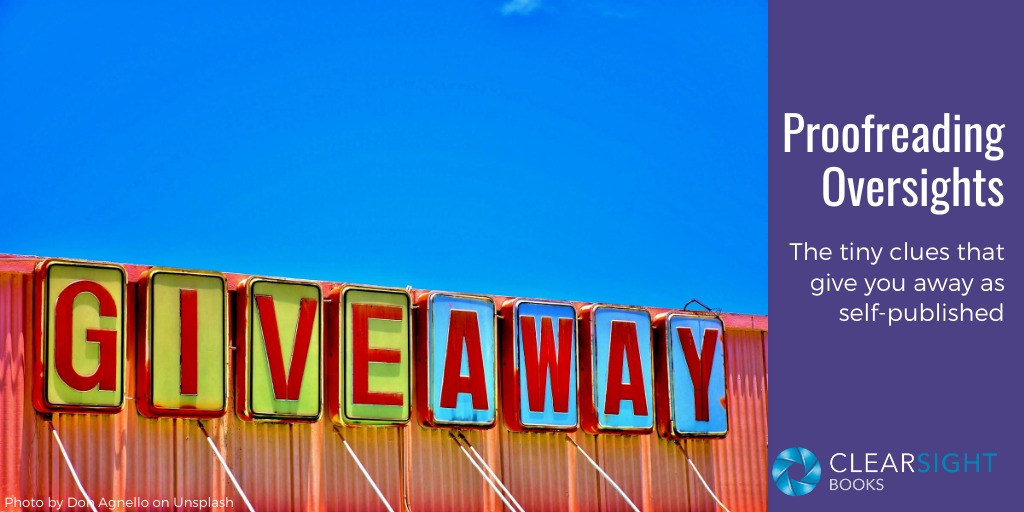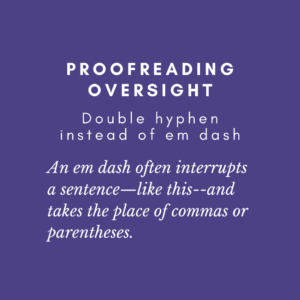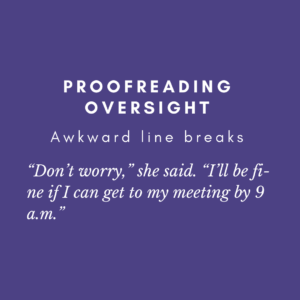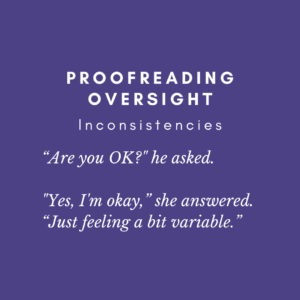
You know you want to self-publish—for control, for speed to market—but you don’t want your book to look self-published. You want it to be indistinguishable from books published by the “Big Five.” But even if you have high quality content and avoid common formatting mistakes, your book may still contain proofreading oversights that give it away.
I recently judged 25 nonfiction books for the Writer’s Digest self-publishing contest. Every single one had at least one of the issues I describe below. While these flaws won’t stop a reader from understanding the narrative, they do give a less professional impression than might be desired.
Proofreading Oversight 1: Incorrect Use of Hyphens and Dashes

Do you know the difference between a hyphen (-), an en dash (–), and an em dash (—)? If not, you’re not alone. (My editor had to bonk me on the head until I got hyphens and en dashes sorted.)
Using the wrong mark, e.g., hyphen instead of en dash, is a proofreading oversight that gives your book away as self-published.
Inconsistent formatting of en and em dashes is another giveaway. One problem is the mixed use/non-use of space around dashes, but I find the biggest eyesore to be the use of a double hyphen (‑‑) for an em dash (—).
The Rules
The Chicago Manual of Style (“Chicago”) sets out plenty of guidelines for the use of hyphens and dashes. Here are the simplest:
- Hyphens (-) are used for compound words (self-published), names (Nate Olson-Schelhaas), and word division (ob-strep-er-ous), such as across line breaks.
- En dashes (–) generally mean “to” and are frequently used for number ranges (1996–2006, 7:30 a.m.–8:30 a.m.). The en dash usually does not have spaces around it.
- Em dashes (—) usually take the place of commas, parentheses, or colons. They often enclose one of those interruptions you insert in a sentence—you know, like this one—that the reader can skip over syntactically. The em dash typically does not have spaces around it.
To be clear, there are other legitimate uses for these marks, and some publishers may choose variations (e.g., in British English, en dashes with spaces are more common than em dashes).
Proofreading Tips
- Use Microsoft Word to automatically convert hyphens to en dashes and double hyphens to em dashes. (Read more on how to create en and em dashes.)
- When proofreading your manuscript, search (Control+F) for [space hyphen space] and [hyphen hyphen]. Replace with en or em dash as appropriate.
Proofreading Oversight 2: Awkward Line Breaks

As noted above, one use of hyphens is to break words across lines. Poor hyphenation and other odd line breaks can trip up your reader as well as flag your book as self-published.
Some of the real-life problematic line breaks I saw while judging books included:
- Incorrect word hyphenation: fi-ne, laugha-ble
- Awkward word hyphenation: intima-cy, re-visit-ed, oth-er, anoth-er, wom-an, anoth-er’s (These look even worse when the final syllable is the only one on the last line of the paragraph.)
- An ellipsis (. . .) split across a line with two dots on one and one dot on the other
- A time split with the numeral on one line and p.m. on the next line (9 <br>p.m.)
The Rules
Text hyphenation allows for more even spacing of words in the paragraph, which makes the reading easier on the eyes. However, it must be done carefully to avoid awkward breaks. Rules of thumb:
- Consult a dictionary (I use Merriam-Webster) for correct hyphenation of syllables.
- Follow Chicago’s guidance to have a minimum of two letters before the hyphen and a minimum of three letters after it.
- Avoid having more than three lines in a row ending with hyphens.
Without getting into every possible guideline for line breaks, here are two more to keep in mind:
- Keep punctuation marks like em dashes (—) and ellipses (. . .) at the end of the line rather than at the beginning of the following line.
- Keep logical elements such as times (8 a.m.) or dates (July 4) together on the same line.
Proofreading Tips
- Skim the right-hand margin of your formatted book interior. Don’t read; just let your eyes look for hyphens and any unusual line breaks.
- If there is a word or phrase that needs to stay together, use a nonbreaking space (Control+Shift+Space), e.g., 9<nbsp>a.m.
Proofreading Oversight 3: Inconsistencies

In one of the books I judged, I suspect there was one editor for most of the book and a different editor for the last few chapters.
The giveaway? Inconsistent use of the Oxford comma—it was used in the first part of the book and not in the last.
In addition to the inconsistent use of the Oxford comma, some of the other real-life giveaways I saw in my latest round of judging included:
- Using both “straight” and “curly” (or “smart”) quotes and apostrophes
- Using both OK and okay
- Using both 1/2 and ½
- Using both AM/PM and a.m./p.m.
- Using hyphenation on some pages and not on other pages
- Inconsistent capitalization of chapter titles and headings, e.g., sometimes title case, sometimes all words capped
Note that many of these items are not problems in and of themselves; it is the inconsistent use that is the problem.
The Rules
Be consistent.
Proofreading Tips
- To avoid inconsistencies, make intentional decisions about your preferred style.
- Keep a running list—a “style sheet”—of your decisions (Oxford comma or not, AM vs. a.m., and so on). Include the correct spelling and capitalization of names and terms as well.
- When proofreading your manuscript, consult your style sheet and methodically search for potential issues (using Control+F); correct as needed.
Do these things really matter?
How much attention should you pay to these fine points of proofreading? As always, I go back to strategy.
For me, the less “permanent” and less formal a piece of writing is, the less these small proofreading oversights matter. For a blog post, I don’t get too tangled up in hyphens and en dashes. And if you look at my writing across the years, most certainly you will find both OK and okay, 8am and 8 a.m.
But a print book has a permanence and formality that requires a higher level of scrutiny. These types of proofreading oversights are red flags for “self-published.” They can distract your readers and damage your authority.
Think back to the day you first sat down to begin writing your book, and take honest stock of all the effort and time you’ve since invested in it. When you’re so close to the finish, why compromise on the quality and polish that come with careful proofreading?

